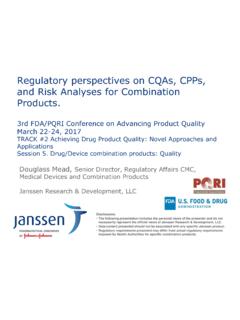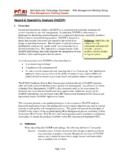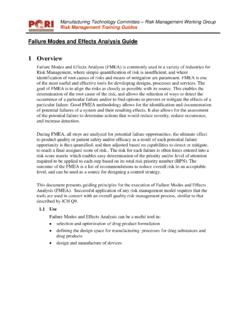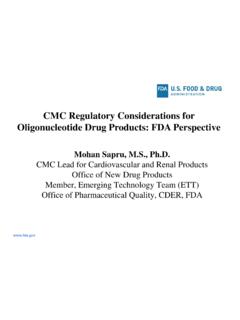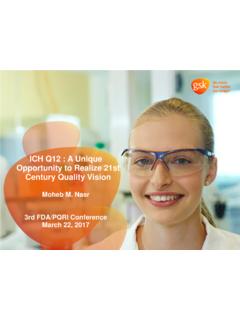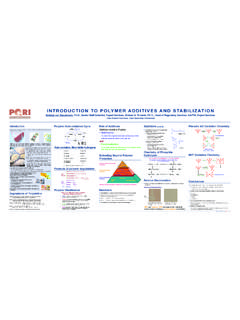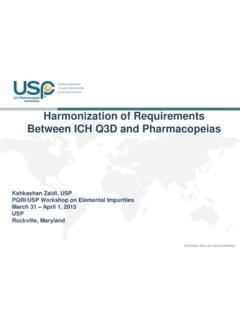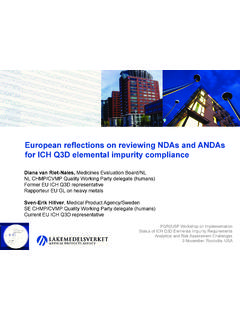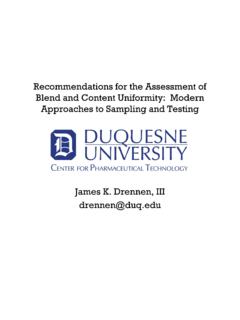Transcription of Safety Thresholds and Best Demonstrated Practices for ...
1 PQRI Confidential 1 Safety Thresholds and Best Demonstrated Practices for Extractablesand Leachablesin Parenteral Drug Products(Intravenous, Subcutaneous, and Intramuscular)PQRI Parenteral and OpthalmicDrug Product Leachablesand ExtractablesWorking Group Update9 September 2020 Product Quality Research Institute (PQRI)PQRI Confidential 2 MISSIONPQRI is a non-profit consortium of organizations working together to generate and share timely, relevant, and impactful information that advances drug product quality, manufacturing, and September 2020 PQRI Structure PQRI consists of two governing bodies the Board of Directors and Steering Committee - and three Technical Committees.
2 Biopharmaceutics Technical Committee (BTC) Development Technical Committee (DTC) Product Quality Technical Committee (PQTC)PQRI Confidential 3 Biopharmaceutics Technical CommitteeManufacturing Technical Committee Development Technical Committee Technical Committees each have a broad disciplinary focus that collectively spans the drug product regulatory lifecycle. They establish and provide scientific guidance, direction and oversight to PQRI working groups and research projects. This presentation is sponsored by the Development Technical Committee (DTC), whose mission is to promote scientific studies to engender science-based regulatory policy relating to the development of drugs and drug products, working with industry, academia, pharmacopeias and regulatory September 2020 PrefaceLeachablesin drug products that originate from the components used in packaging, delivery, and manufacturing systems can compromise the quality of drug products and impact patient Safety .
3 The materials of construction associated with these components should be assessed for suitability in early drug development phases based on extractable profiles and correlated to potential and confirmed leachables. In 1999 the PQRI Leachablesand Extractables(L&E) Working Group was established with the goal of reducing leachable uncertainty in Orally Inhaled or Nasal Drug Products (OINDP) using a science and risked based approach. The Working Group was made up of highly experienced scientists including toxicologists, analytical chemists, and others, from industry, government, and academia.
4 The culmination of these efforts resulted in L&E recommendations to the US FDA. Safety Thresholds and Best Practices for Leachablesand Extractablesin OINDP" was published in 2006 and since has been recognized by FDA and global regulatory authorities. In 2008 the Parenteral and Ophthalmic Drug Product Leachablesand Extractables(PODP L&E) Working Group was formed to extrapolate the OINDP risked based approach for evaluation and Safety qualification of leachablesin PODP, with consideration of factors and parameters such as dose, duration, patient population.
5 And additional product-dependent Confidential 4 The views expressed in this presentation are not necessarily those of the US Food and Drug Administration9 September 2020 PrefaceThe PODP Working Group conducted and evaluated the results of extraction studies on polymeric materials and evaluated a database of over 600 potential leachables using current toxicological qualification approaches to justify Thresholds for proposed PODP identification and qualification Thresholds were published in a 2013 manuscript followed by two workshops. Subsequently, PQRI Safety Thresholds and Best Demonstrated Practices for Extractables and Leachables in Parenteral Drug Products (PDP) , was finalized and is expected to be published in 2020.
6 Included in the PDP recommendations are considerations for L&E assessments for biological products. Parenteral products administered by the intrathecal, intra-cerebroventricular, intra-articular, epidural, and perineural routes are out of scope. Study designs for L&E are case by case and should be discussed early with the Regulatory Agency to understand the proper application of the analytical evaluation threshold (AET), extraction concentrations, solvents, exposure conditions, and analysis. There are unique considerations for ophthalmic drug products (ODP), and Thresholds do not apply.
7 A separate manuscript is tobe published entitled Principles for Management of Extractables and Leachables in Ophthalmic Drug Products (ODP). The recommendations were the result of understanding a broad range of L&E applications over several years of building consensus with leaders in the scientific and regulatory community. Contributions of individuals from the core team, extended teams, reviewers, and advisors are sincerely appreciated. On behalf of the PQRI L&E Working Group, the following PDP update is presented and a list of individual contributors is in the closing Paskiet, PQRI DTC Chair and PODP L&E Working Group Chair, Representing the Parenteral Drug Association (PDA)
8 PQRI Confidential 5 The views expressed in this presentation are not necessarily those of the US Food and Drug Administration9 September 2020 Presentation Concepts PODP Update SCT, AET, QT vs TTC and ICH Materials and Study Considerations studies Challenging AET Semipermeable Materials Non-targeted Assessments Targeted and FAQPQRI Confidential 69 September 2020 Threshold ConceptsPQRI Confidential 7 Safety Concern Threshold (SCT) threshold below which a leachable would have a dose so low as to present negligible Safety concerns from mutagenic and non-mutagenic toxic effects represented as absolute exposures, expressed in total daily intake (TDI) converted into relative amounts SCT is risk-based and specific to route of administration Qualification Threshold (QT) Assessment of non-mutagenic Identified leachables > 5 g/day for OINDP Analytical Evaluation Threshold (AET)
9 Identification threshold calculated from the SCT and utilized for potential toxicological assessmentsThreshold concepts introduced by the September 2006 PQRI-OINDP E&L Recommendations9 September 2020 Application of SCT-derived AET exchanges look as low as you can ..13. 5014. 0014. 5015. 0015. 5016. 0016. 5017. 0005000010000015000020000025000030000035 0000400000450000500000 Time--> Concept: AET and ChromatographyPQRI Confidential 8 AETS ubstances below the AET do not have to be identifiedSubstances above the AET:Identifyand reportto a toxicologist for a risk assessment.
10 For a scientifically-justified, consistent standard for how low to identify and report9 September 2020 PQRI Confidential 9 PDP Identification Threshold: SCT DerivedAET expressed as leachables per containerAET expressed as extractable (wt/wt) device componentThe AET is not a control threshold but a trigger point for identification and potential toxicological assessment. 9 September 2020 SCT vs TTC and ICH M7 PQRI Confidential 10 SCTF actor to calculate AETTTC Applicable to Identified MutagensDocumentationPQRI-OINDP RecommendationsPQRI-PDPR ecommendationsICH M7 For Identified g/day g/dayLifetime cancer risk10-610-510-5 Purpose Calculation of an AET for E&L, an ID and reporting threshold Not a control threshold Leachables are not required to be below SCTL imiton daily intake of mutagenic impurities from drug substance or productApplication of ICH M7 to leachables is not intended.

